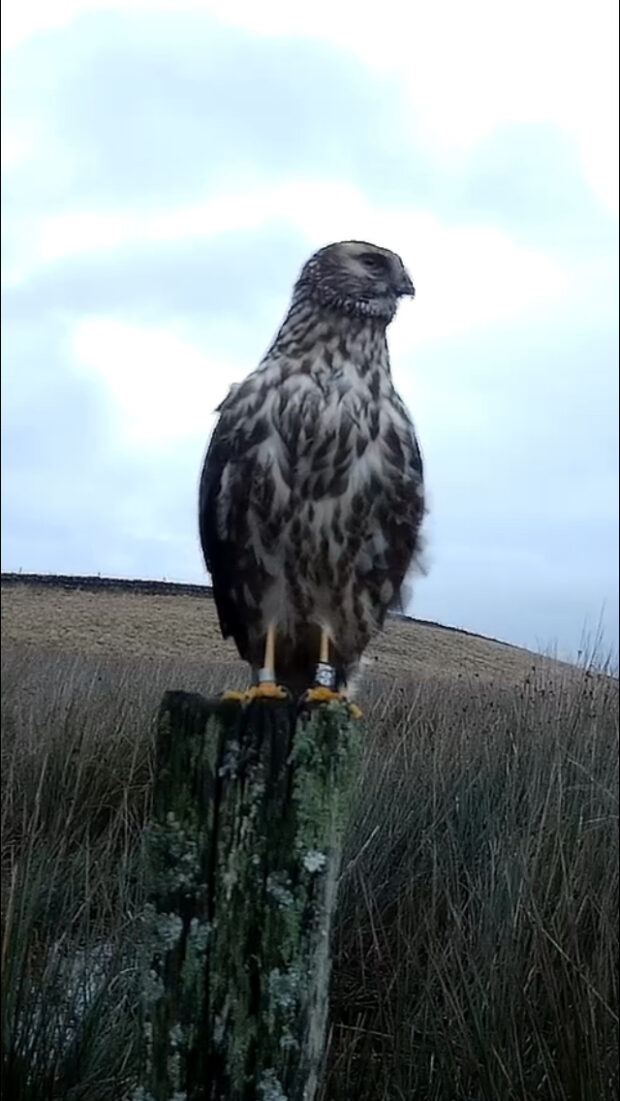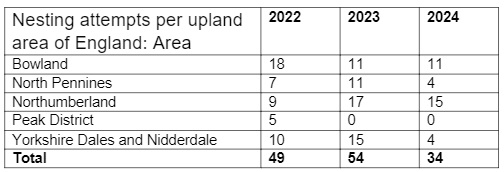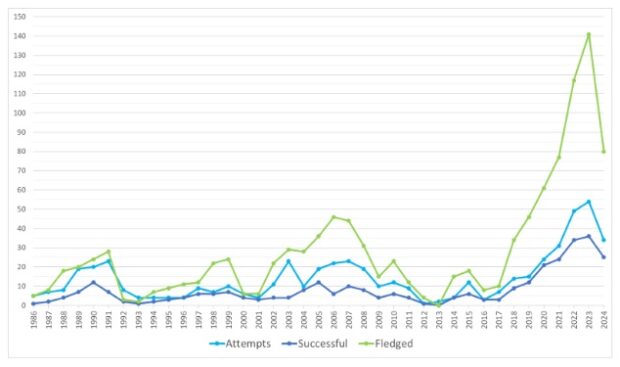
Hen harriers are very rare birds of prey found in moorland landscapes. They are rare because of illegal killing and disturbance, and Natural England monitors their numbers closely, tags individual birds to track their whereabouts, and supports efforts to tackle wildlife crime.
In recent years, numbers of nesting hen harriers in England had been steadily increasing, but the numbers this season are lower than the last two years.
Breeding figures and regional breakdown
In 2024, Natural England and partners recorded a total of 34 breeding attempts in England (down from 54 in 2023) of which 25 were successful (36 in 2023), fledging 80 chicks (141 in 2023). This gives an average of 3.2 chicks per successful nest (3.9 in 2023).
We did not record any second breeding attempts in 2024. Therefore, it is estimated that there were a minimum of 34 breeding females in England (50 in 2023). One satellite tagged female and two tagged males attempted to breed in Scotland and Wales.


The English hen harrier population is small, and numbers may naturally fluctuate year-to-year. Possible explanations for the decline in numbers this year include poor weather in spring 2024, and low numbers of small mammals and birds, which the harriers feed on. The numbers of chicks fledged per successful nest was down on last year (3.2 compared to 3.9), suggesting that parent birds may have been finding it harder to feed their chicks.
Despite the poor weather, numbers of nesting hen harriers remained steady in Bowland and Northumberland, and declines were most noticeable in parts of the North Pennines and the Yorkshire Dales, regions where hen harriers tend to nest in areas managed for grouse shooting.
Hen Harrier Action Plan and illegal killing of harriers.
In 2016, Defra published the Hen Harrier Action Plan. This set out actions to increase Hen Harrier numbers, mostly designed to reduce illegal killing, through improved police enforcement of wildlife crime, and finding ways to promote the coexistence of hen harriers and grouse shooting, such as providing alternative food to nesting harriers (diversionary feeding) and trialling ‘brood management’ (see below). Another part of the action plan is the Southern England Hen Harrier Reintroduction Project.
One of NE’s responsibilities under the Hen Harrier Action Plan is tagging and tracking individual birds, to identify important sites for Hen Harriers and to monitor survival rates. Natural England tagged eight chicks in 2024, out of the 80 that fledged this year, and the status of all tagged birds is periodically reported on our Hen Harrier Tracking Update page. In January this year we reported that losses of tagged Hen Harriers were higher than normal, heightening concerns of illegal killing.
We had been encouraged by the increased numbers of hen harriers breeding in recent years, so the drop in numbers this year, together with the losses of tagged birds last winter, is concerning. We will continue to direct our efforts towards science, monitoring, enforcement, and conservation management to support the recovery of these at-risk birds.
Brood management
The brood management trial, which ran between 2018 and 2024, aimed to test whether the availability of this technique would lead to changes in the attitudes of grouse moor managers towards Hen Harriers, reduced levels of illegal killing, and a sustained increase/recovery in the number of Hen Harriers nesting successfully in the uplands of Northern England. The trial has been run by a partnership that included Natural England.
The research licences that Natural England issued for the Hen Harrier brood management trial between 2018 and 2024 have now expired. No nests were brood managed in 2024.
The Hen Harrier Action Plan states: “If the trial…is successful, [brood management] would be available as an ongoing tool for grouse moors to conserve hen harriers, to be used under licence from Natural England.” Natural England is currently reviewing and analysing the data gathered under the trial, a process which will be concluded later this year. These findings will play a critical role in informing Natural England’s judgement as to the effectiveness of brood management as a conservation technique.
Our monitoring partners
We are grateful for the efforts of all of our partners to monitor, protect and manage hen harrier nests and breeding habitats. We work closely with RSPB staff who record the nesting attempts on RSPB reserves, and on the United Utilities Estate in Bowland. We are also grateful for the contributions of volunteer Raptor Study Groups and Natural England volunteers to nest monitoring, and to landowners and agencies including Forestry England, National Parks, National Landscapes, the National Trust, NatureScot and Natural Resources Wales.
Natural England field staff lead on liaison with privately-owned grouse shooting estates, and, alongside the Moorland Association, with those land managers that are encouraging hen harriers to nest successfully alongside their wider estate management for grouse and other wildlife. Natural England staff oversee the monitoring and tagging of these nests, and provide support and guidance on diversionary feeding, aided by funding from the British Association for Shooting and Conservation (BASC) legacy fund. We recognise the efforts put in by all these organisations, estates and their staff.
19 comments
Comment by Richard Watson posted on
I live in West Cumbria and have walked in the Lake District fells for many years. I've never seen a hen harrier. Why are these moorland birds absent? I'm guessing that the answer lies in overgrazing by sheep which leaves the hills barren and devoid of the small mammals on which hen harriers might prey. Such a pity. And so unnecessary.
Comment by Charles Grisedale posted on
Bad Weather has played a big part . Here Canada and Greylag geese fledging down from 70 + to 11 birds .
Grouse numbers collapsed as well = food !
Comment by Darren Hogg posted on
Totally agree with your comments, all birds in the UK had a horrible spring, Robins, Blue tits, grouse, partridge, Curlew, Lapwings .. I walked our RSPB reserve the other day and did not see one bird.
Comment by Christopher Lampshire posted on
I monitor a dormouse wood in Somerset and at the start of the season the nest boxes are usually full of blue tit nests. This year many were abandoned with unhatched eggs or dead young. Very sad as usually there are two broods at least. Dormouse numbers have plummeted too in the South West.
Comment by Erica D Wilson posted on
The drop in number of nesting hen harriers is very alarming situation
Comment by David R Holmes posted on
Not the only species to have suffered this spring, bird numbers and fledging rates are lower this year. Grouse broods and breed success also very patchy. Grey partridge on moor edges have dipped this season, following steady increases recently. A miserable spring and early summer for anything trying to raise young in a moorland environment.
Comment by Jay posted on
The weather on the moors during breeding season was horrific
Put 2 and 2 together I would suggest
It’s not all about persecution and illegal killing on
Comment by Darren Hogg posted on
Well said
Comment by Jay posted on
Be less and less once areas are afforested
Comment by Dan posted on
It's quite clear where the problem lies and why action is never taken against the perpetrators
Comment by Keith Garland posted on
Can they be monitored if they travel away from their home moor if food is scarse?
Comment by Richard posted on
Couldn't be anything to do with the bad spring could it
Comment by Lesf posted on
If there hadn't been persecution then the bad spring would have little effect on a healthy population. It's because the numbers are so low to begin with.
Comment by Gerald Brawn posted on
It doesn't make much sense for NE to operate a Hen Harrier breeding / protection project with the lobbying representatives of those who are carrying out the illegal killing.
The NE text above rather bizarrely pretends that BASC and Moorland Assoc members have no involvement in illegally killing Hen Harriers.
Comment by Wayne Cooper posted on
It's pretty obvious why there is a decline in England. Shooting industry and gamekeepers. Stop prevarication and prosecute effectively
Comment by Gregg posted on
It's been a dreadful year for grouse because of the weather, and considering that the breeding season for all birds has been dire across all moorland and not that used for shooting makes your comment nil and void.
Comment by John Grover posted on
The RSPB condemn grouse shooting, yet grouse moors produce more harrier than their reserves.In fact they hate all shooting,but wildlife thrives on all estates and farms where shooting takes place.
Comment by Quercus posted on
Just to be clear, the figures relate to nesting attempts. The poor weather could undoubtedly have affected pairs with eggs or young but would it have so dramatically reduced the number of pairs in, for example, the North Pennines (11 pairs down to 4), Yorkshire Dales and Nidderdale (15 pairs down to 4 ) areas? It is not unreasonable to conclude that the probable explanation is that the base population in those areas has declined, it being noted that NE has referred to the 'heightening concerns of illegal killing' and has highlighted the fact that these are areas in which grouse shooting takes place.
The lower figures reported come as no great surprise. They are undoubtedly a reflection of the reaction in certain quarters to the promising figures of 54 young raised in 2023, almost half of which occurred in the areas noted above.
Comment by Matthew Stone posted on
Tagging only eight chicks this year seems a missed opportunity to really collate more substantial evidence on when, where and possibly why individual birds go missing. Whilst tags are expensive (c.£1k+ each?) this is small fry compared to the cost of one gun shooting for a day or all the time stakeholder management etc. You could potentially tag half of all chicks for £50,000 …and get ever increasing definitive evidence to inform real change.